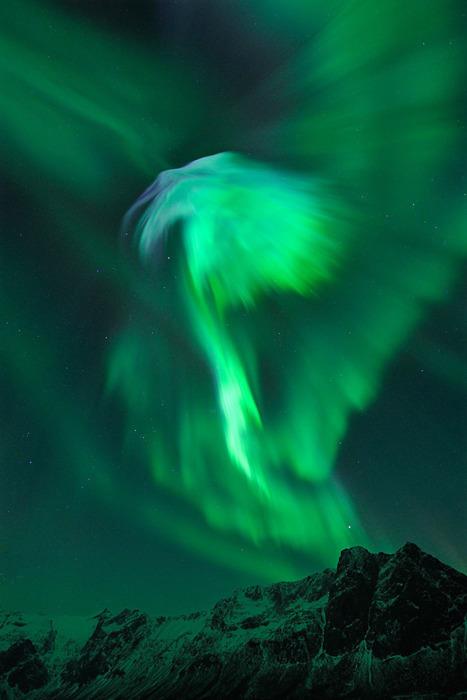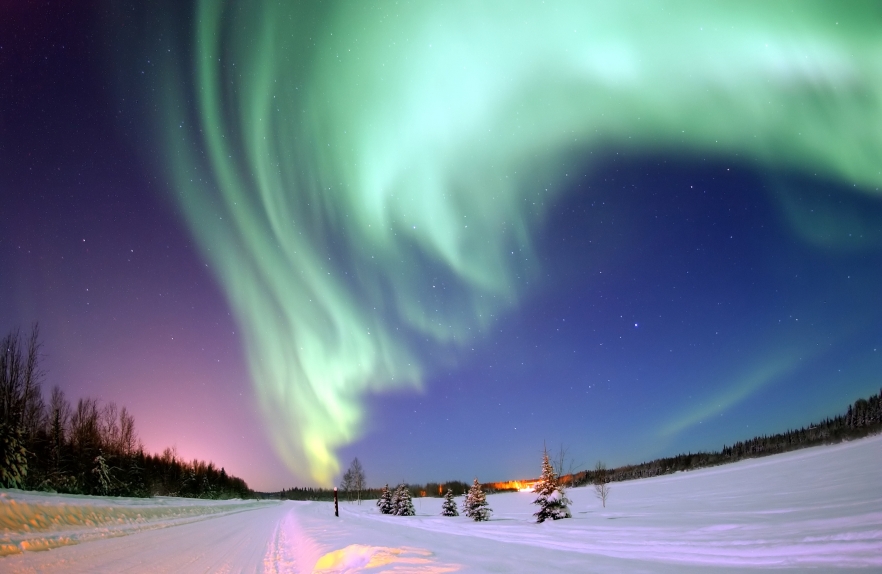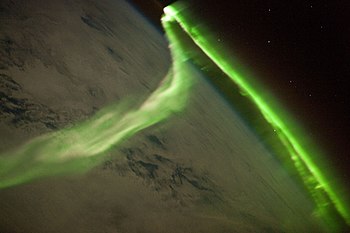An aurora happens when energetic electrically charged particles, like electrons, collide with atoms of gas as they accelerate along the Earth’s magnetic field lines in the upper atmosphere.
Those collisions cause the atoms to give off light. Auroras are a lot like neon signs, except that the conducting gas is in the Earth’s ionosphere instead of inside a glass tube.

Frequently Asked Questions about Auroras

University of Alaska ~ Geophysical Institute
If you don’t find your answer here, you might try the FAQ at Poker Flat, or the Asahi Aurora Classroom. For even more in-depth information, I recommend David Stern’s educational files. A very nice and in-depth website with lots of animations is the COMET program at HAO (free, but registration is required). A good book (it’s hard to put web pages on a shelf…) that I recommend is “The Aurora Watcher’s Handbook” by Neil Davis.

Links to real-time geophysical data that are related to the aurora and aurora forecast can be found at University of Alaska Fairbanks. Links to websites with auroral photography and information are NASA, Aurora Service EU, Alaska Photographics, more links here, Michigan Tech & at Aurora Notify.

|
A luminous atmospheric phenomenon appearing as streamers or bands of light sometimes visible in the night sky in northern or southern regions of the earth. It is thought to be caused by charged particles from the sun entering the earth’s magnetic field and stimulating molecules in the atmosphere.
Auroras: What makes them happen?
Before we can understand auroras, we need a few facts about the space around our Earth. There are many things in this space that we can’t see.
One thing is the air we breathe, our atmosphere. It is really a mixture of several gasses, mostly nitrogen and oxygen, with traces of hydrogen, helium and various compounds.
A Field of Earth
Another thing we can’t see is a magnetic field that surrounds the Earth. If you’ve ever played with a bar magnet and iron filings you’ve seen the curved patterns the filings form in the magnetic field. The next picture shows how the magnetic field around the earth’s core is like the field of a bar magnet.



~*~
This wind is always pushing on the Earth’s magnetic field, changing its shape. You change the shape of a soap bubble in a similar way when you blow on its surface. We call this compressed field around the earth the magnetosphere. The Earth’s field is compressed on the day side, where the solar wind flows over it. It is also stretched into a long tail like the wake of a ship, which is called the magnetotail, and points away from the Sun
 |
Squeezing the Earth’s magnetic field takes energy, just the way it takes energy to compress a balloon with air in it. The whole process is still not fully understood, but energy from the solar wind is constantly building up in the magnetosphere, and this energy is what powers Auroras: (a full story)
Can I see them anywhere?
Yes. Although more frequent at higher latitudes, closer to the poles (such as in Canada, Alaska, Antarctica), they have been seen closer to the equator as far south as Mexico. To view them, look in the direction of the closest pole (the northern horizon in the northern hemisphere, the southern horizon in the southern hemisphere).
Can I see them at any time of the year?
Yes. In some areas, such as Alaska or Greenland, they may be visible most nights of the year. And they occur at any time of the day, but we can’t see them with the naked eye unless it’s dark.
What causes the colors and patterns?
Colors and patterns are from the types of ions or atoms being energized as they collide with the atmosphere and are affected by lines of magnetic force. Displays may take many forms, including rippling curtains, pulsating globs, traveling pulses, or steady glows. Altitude affects the colors. Blue violet/reds occur below 60 miles (100 km), with bright green strongest between 60-150 miles (100-240 km). Above 150 miles (240 km) ruby reds appear.


Read More on the Actual Look of Auroras without photography enhancement; ie: usually milky white or even grey.


Related articles
- A wonderful Arctic Website (Aqua Firma)
- Aurora lecture on channel 15 (auroranotify.com)
- Aurora Hunter (Website and Knowledge base)
- Unfurled aurora (blogs.discovermagazine.com)
- Aurora (Wikipedia)
- Aurora Pictures: Best Fall Photos of Northern Lights (news.nationalgeographic.com)










Oh my my … Simply awesome. The information, the music, the images, the links. Much going on here … it’s kind of an Aurora Playground! Thanks for leading me to this, and I foresee me mentioning this post in the future!
LikeLike
Thanks! Glad you enjoyed the article! I plan to keep most of my postings updated from time to time, to help minimize the amount of them; thus making them somewhat current and informational.
Also as Interactive as possible; With many links and yes.. Music! 😀
Sasha
LikeLike
simply enchanting! 😀
LikeLike
Thanks for the compliment! I also like your blogs! Intriguing! 🙂
LikeLike
Beautiful post! You’ve really taught me a lot! 🙂
LikeLike
Thanks Wesley, I’m glad you enjoyed it so.. Thanks also for following, I’ve done the same, and on twitter as well..! Have a lovely day!
LikeLike
Hey Sasha … just wanted to say Happy New Year.
LikeLike
Hi there, Frank! Thank you, Happy New Year to you as well! 🙂
LikeLike
🙂
LikeLike
Oh, dear, I reblogged so not sure how the pingback thing works. But I thought this was an interesting share for many who enjoy the lights but don’t understand the science behind them. I didn’t either. Because of my chosen name on here, I especially wanted to read and share. My name, as defined by me, means: Aurora = Light; Mo=Short for More; Realist =just that. So your piece was intriguing for more than one reason. Thanks! Happy to share 🙂
LikeLike
Thanks Aurora! Great name to choose I too have many reasons both for my ‘afreestyler’ nickname and Sasha (name I use all the time) Nice to ‘choose’ ones own name! 🙂
Sasha 🙂
LikeLike
Very interesting and well-written blog, thanks!
LikeLike
Thanks Nick 🙂 I enjoyed your blog to, especially the Astronomy section..
LikeLike